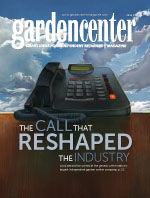|
It’s a busy time, so for this month’s article the wording is short and the visuals are strong. (Who cheered?)
On my 30-year journey through the independent garden retail channel, I have seen thousands of attempts at signage programs. From hand-written, misspelled messages on the back of someone else’s signs to sophisticated high-tech tapestries 12 feet by 20 feet.
Here’s the common reply I used to get when I suggested using more signs: “You want to make my place look like Walmart?!” These people thought that (1) signs made the place look untidy, and (2) signs were unnecessary because all customers were helped one-on-one by knowledgeable employees. Style and “look” certainly impact ambiance and perceived value to the consumer, but consider this notion: Managers and employees want a place they are visually proud of without signs dominating or obscuring their beautiful products; customers want a successful shopping experience.
Just tell me what I need to do
Today’s emerging garden consumers want simple answers to the plea, “Just tell me what to do and where I need to do it.” They want simple, visual solutions that engage, inform, assure and inspire; without a word being said.
The essence of any sign program should be to see needs through the consumer’s eyes, not the retailer’s. In fact, you could apply “Think Like A Customer” to this subject, too.
Some retailers still think that signage is expensive. When compared with the labor or advertising budget (from which it should be funded) I think the amount is small and offers a much better return on investment.
The 4-step program
I like to break a signage needs into four levels, each represented by a query in the customer’s mind:
Level 1: Where is it or where are your …?
Level 2: What am I looking at …?
Level 3: What will it do for me…? (Close the sale!)
Level 4: Surprise me. Inspire me! Tempt me!

1. A good Level 1 sign. Icons ics and clear wording make this quick and easy to follow. 2. This Level 2 sign helps unravel the mystery of the chemical dept—and with a whimsical cartoon, too. 3. Here are two Level 3 signs that deliver solutions. They’ll have the customer thinking, “That’s something really helpful that no one could tell me at that other place.” 4. This Level 4 sign helps the store connect with its customers. Eventually, they’ll think, “I always look at this table; these people know their stuff here.” 5. Here’s an example of how signage can build ambiance very cost-effectively. 6. Here’s a great combination sign that contains visuals, suggested use and the company logo. This sign engages, informs and assures in professional style, and it didn’t cost a fortune.
Level 1 was always answered by large signs named after well-known products such as Shade Trees, or categories like Lawn Care. Emerging customers respond better to words or phrases that relate to their lives such as Tall Trees, Fragrant Shrubs, Incredible Edibles, Lawn Food and so on.
Level 2 replaces an employee’s verbal product knowledge. “This plant gets 5-feet high by 3-feet wide, with dense leaves and deep blue flowers in summer,” “$8.99 for a 1-gallon;” “$24.99 for a 3-gallon.” Factual but not exactly emotional.
Level 3 adds the emotional “Ka-Ching” line that many employees fail to understand and use when talking to a customer. Hobbyists might read No. 2 above and relate, but the emerging consumers need much more to overcome their lack of information and confidence. Signage has to connect the dots for them with an additional phrase like, “Dense, year-round bush makes this a great privacy plant.” “Blue flowers go with white, gray or yellow trim.” “A good plant for busy people.” “Loves our local soil!”
Notice all those emotional words such as year-round, privacy, pets, kids, busy people, etc., that customers can relate to their own lives.
Level 4 can both introduce excellent products that customers had no idea existed such as the quarter-inch soaker hose for veggie gardens, or something that signs and/or displays make just irresistibly cute. Humor can be a great addition here; people love cute or whimsical phrases such as “Berried Treasure.” Signs can tempt people with financial incentive, too, such as “Hide the neighbors for $99.” Temptations should be aimed at the senses as well as the wallet. Just reading a label on a Rose called ‘Jude The Obscure’ that says “…on a warm day smells of summer strawberries and crisp white wine” would tempt many to indulge in buying the rose.
Imagine That!
As well as helping customers to spend, a signage program sets or re-enforces the tone of the company. Signs can build ambiance and create the shopping experience (good or bad). Some managers expect employees to have clean uniforms, yet never think of fading or obsolete signs as having the same impact on ambiance. The brand image of the company can be upgraded very quickly with a professional, coordinated sign program.
Thyme is short
This industry has so many products that don’t look, sound or smell very emotional or inspirational. In previous decades shoppers could connect most dots, so signage was functional, informative and dry. Nowadays as garden center shopping time declines, signage has to attract, engage, inform, inspire and assure in a few minutes, without a word being said—and all for the price of one part-time employee!
Contributing editor Ian Baldwin offers other useful ideas in his “TLC … Think Like Customers” sales training program, available at www.ianbaldwin.com.
|








